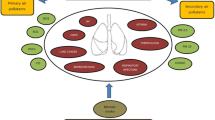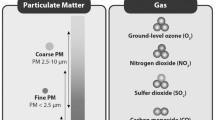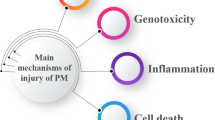Abstract
Recommended standardized procedures for determining exhaled lower respiratory nitric oxide and nasal nitric oxide (NO) have been developed by task forces of the European Respiratory Society and the American Thoracic Society. These recommendations have paved the way for the measurement of nitric oxide to become a diagnostic tool for specific clinical applications. It would be desirable to develop similar guidelines for the sampling of other trace gases in exhaled breath, especially volatile organic compounds (VOCs) which may reflect ongoing metabolism. The concentrations of water-soluble, blood-borne substances in exhaled breath are influenced by: (i) breathing patterns affecting gas exchange in the conducting airways, (ii) the concentrations in the tracheo-bronchial lining fluid, (iii) the alveolar and systemic concentrations of the compound. The classical Farhi equation takes only the alveolar concentrations into account. Real-time measurements of acetone in end-tidal breath under an ergometer challenge show characteristics which cannot be explained within the Farhi setting. Here we develop a compartment model that reliably captures these profiles and is capable of relating breath to the systemic concentrations of acetone. By comparison with experimental data it is inferred that the major part of variability in breath acetone concentrations (e.g., in response to moderate exercise or altered breathing patterns) can be attributed to airway gas exchange, with minimal changes of the underlying blood and tissue concentrations. Moreover, the model illuminates the discrepancies between observed and theoretically predicted blood-breath ratios of acetone during resting conditions, i.e., in steady state. Particularly, the current formulation includes the classical Farhi and the Scheid series inhomogeneity model as special limiting cases and thus is expected to have general relevance for a wider range of blood-borne inert gases. The chief intention of the present modeling study is to provide mechanistic relationships for further investigating the exhalation kinetics of acetone and other water-soluble species. This quantitative approach is a first step towards new guidelines for breath gas analyses of volatile organic compounds, similar to those for nitric oxide.
Similar content being viewed by others
References
Amann, A, Smith, D (eds) (2005) Breath analysis for clinical diagnosis and therapeutic monitoring. World Scientific, Singapore
Amann A, Poupart G, Telser S, Ledochowski M, Schmid A, Mechtcheriakov S (2004) Applications of breath gas analysis in medicine. Int J Mass Spectrom 239: 227–233
Amann A, Spanel P, Smith D (2007) Breath analysis: the approach towards clinical applications. Mini Rev Med Chem 7: 115–129
Ammann C, Brunner A, Spirig C, Neftel A (2006) Technical note: water vapour concentration and flux measurements with PTR-MS. Atmos Chem Phys Discuss 6: 5329–5355
Anderson JC, Hlastala MP (2007) Breath tests and airway gas exchange. Pulm Pharmacol Ther 20: 112–117
Anderson JC, Babb AL, Hlastala MP (2003) Modeling soluble gas exchange in the airways and alveoli. Ann Biomed Eng 31: 1402–1422
Anderson JC, Lamm WJ, Hlastala MP (2006) Measuring airway exchange of endogenous acetone using a single-exhalation breathing maneuver. J Appl Physiol 100: 880–889
Angeli D, Sontag E (2003) Monotone control systems. IEEE Trans Automat Control 48: 1684–1698
Anguelova M (2007) Observability and identifiability of nonlinear systems with applications in biology. PhD thesis, Chalmers University of Technology and Göteborg University
Banks HT, Fitzpatrick BG (1990) Statistical methods for model comparison in parameter estimation problems for distributed systems. J Math Biol 28: 501–527
Banks HT, Tran HT (2009) Mathematical and experimental modeling of physical and biological processes. CRC Press, Boca Raton
Beck JV, Arnold KJ (1977) Parameter estimation in engineering and science. Wiley, New York
Birken T, Schubert J, Miekisch W, Noldge-Schomburg G (2006) A novel visually CO2 controlled alveolar breath sampling technique. Technol Health Care 14: 499–506
Bock HG (1981) Numerical treatment of inverse problems in chemical reaction kinetics. In: Ebert K, Deuflhard P, Jäger W Modelling of chemical reaction systems. Springer, Heidelberg
Bock HG (1987) Randwertproblemmethoden zur Parameteridentifizierung in systemen nichtlinearer differentialgleichungen. PhD thesis, Universität Bonn
Brundin T (1975) Temperature of mixed venous blood during exercise. Scand J Clin Lab Invest 35: 539–543
Clewell HJ, Gentry PR, Gearhart JM, Covington TR, Banton MI, Andersen ME (2001) Development of a physiologically based pharmacokinetic model of isopropanol and its metabolite acetone. Toxicol Sci 63: 160–172
Cobelli C, DiStefano JJ (1980) Parameter and structural identifiability concepts and ambiguities: a critical review and analysis. Am J Physiol 239: R7–R24
Cope KA, Watson MT, Foster WM, Sehnert SS, Risby TH (2004) Effects of ventilation on the collection of exhaled breath in humans. J Appl Physiol 96: 1371–1379
Crofford OB, Mallard RE, Winton RE, Rogers NL, Jackson JC, Keller U (1977) Acetone in breath and blood. Trans Am Clin Climatol Assoc 88: 128–139
Farhi LE (1967) Elimination of inert gas by the lung. Respir Physiol 3: 1–11
Galassetti PR, Novak B, Nemet D, Rose-Gottron C, Cooper DM, Meinardi S, Newcomb R, Zaldivar F, Blake DR (2005) Breath ethanol and acetone as indicators of serum glucose levels: an initial report. Diabet Technol Ther 7: 115–123
Golub GH, Van Loan CF (1996) Matrix computations, 3rd edn. Johns Hopkins University Press, Baltimore
Hahn CEW, Farmery AD (2003) Gas exchange modelling: no more gills, please. Br J Anaesth 91: 2–15
Hairer E, Norsett SP, Wanner G (1993) Solving ordinary differential equations 1: nonstiff problems, 2nd edn. Springer, Berlin
Hanna LM, Scherer PW (1986a) Regional control of local airway heat and water vapor losses. J Appl Physiol 61: 624–632
Hanna LM, Scherer PW (1986b) A theoretical model of localized heat and water vapor transport in the human respiratory tract. J Biomech Eng 108: 19–27
Herbig J, Titzmann T, Beauchamp J, Kohl I (2008) Buffered end-tidal (BET) sampling—a novel method for real-time breath-gas analysis. J Breath Res 2: 1–9
Hermann R, Krener AJ (1977) Nonlinear controllability and observability. IEEE Trans Automat Control 22: 728–740
Horbelt W, Timmer J, Voss H (2002) Parameter estimation in nonlinear delayed feedback systems from noisy data. Phys Lett A 299: 513–521
Hughes JMB, Morell NW (2001) Pulmonary circulation, from basic mechanisms to clinical practice. Imperial College Press, London
Jacquez JA, Greif P (1985) Numerical parameter identifiability and estimability: integrating identifiability, estimability and optimal sampling design. Math Biosci 77: 201–227
Jacquez JA, Perry T (1990) Parameter estimation: local identifiability of parameters. Am J Physiol 258: E727–E736
Ji-Fa J (1994) On the global stability of cooperative systems. Bull Lond Math Soc 26: 455–458
Johanson G (1991) Modelling of respiratory exchange of polar solvents. Ann Occup Hyg 35: 323–339
Jones AW (1982) Effects of temperature and humidity of inhaled air on the concentration of ethanol in a man’s exhaled breath. Clin Sci 63: 441–445
Jones AW (1983) Role of rebreathing in determination of the blood-breath ratio of expired ethanol. J Appl Physiol 55: 1237–1241
Kalapos MP (2003) On the mammalian acetone metabolism: from chemistry to clinical implications. Biochim Biophys Acta 1621: 122–139
Keck L, Hoeschen C, Oeh U (2008) Effects of carbon dioxide in breath gas on proton transfer reaction-mass spectrometry (PTR-MS) measurements. Int J Mass Spectrom 270: 156–165
Keller U, Schnell H, Girard J, Stauffacher W (1984) Effect of physiological elevation of plasma growth hormone levels on ketone body kinetics and lipolysis in normal and acutely insulin-deficient man. Diabetologia 26: 103–108
King J, Kupferthaler A, Unterkofler K, Koc H, Teschl S, Teschl G, Miekisch W, Schubert J, Hinterhuber H, Amann A (2009) Isoprene and acetone concentration profiles during exercise on an ergometer. J Breath Res 3, 027,006 (16 pp)
King J, Koc H, Unterkofler K, Mochalski P, Kupferthaler A, Teschl G, Teschl S, Hinterhuber H, Amann A (2010a) Physiological modeling of isoprene dynamics in exhaled breath. J Theor Biol 267: 626–637
King J, Mochalski P, Kupferthaler A, Unterkofler K, Koc H, Filipiak W, Teschl S, Hinterhuber H, Amann A (2010b) Dynamic profiles of volatile organic compounds in exhaled breath as determined by a coupled PTR-MS/GC-MS study. Physiol Meas 31: 1169–1184
King J, Unterkofler K, Kupferthaler A, Teschl G, Teschl S, Koc H, Hinterhuber, H, Amann A (2010c) A modeling based evaluation of isothermal rebreathing for breath gas analysis of highly soluble volatile organic compounds. https://homepages.fhv.at/ku/karl/pdfs/IRB2010.pdf. Technical Report, Breath Research Institute of the Austrian Academy of Sciences
Kuhn E, Lavielle M (2005) Maximum likelihood estimation in nonlinear mixed effects models. Comput Stat Data Anal 49: 1020–1038
Kumagai S, Matsunaga I (1995) Physiologically based pharmacokinetic model for acetone. Occup Environ Med 52: 344–352
Kumagai S, Matsunaga I (2000) A lung model describing uptake of organic solvents and roles of mucosal blood flow and metabolism in the bronchioles. Inhal Toxicol 12: 491–510
Kumagai S, Oda H, Matsunaga I, Kosaka H, Akasaka S (1999) Uptake of 10 polar organic solvents during short-term respiration. Toxicol Sci 48: 255–263
Kundu SK, Bruzek JA, Nair R, Judilla AM (1993) Breath acetone analyzer: diagnostic tool to monitor dietary fat loss. Clin Chem 39: 87–92
Leenheer P, Angeli D, Sontag E (2007) Monotone chemical reaction networks. J Math Chem 41: 295–314
Lindberg L, Brauer S, Wollmer P, Goldberg L, Jones A, Olsson S (2007) Breath alcohol concentration determined with a new analyzer using free exhalation predicts almost precisely the arterial blood alcohol concentration. Forensic Sci Int 168: 200–207
Lindinger W, Hansel A, Jordan A (1998a) On-line monitoring of volatile organic compounds at pptv levels by means of proton-transfer-reaction mass spectrometry (PTR-MS)—medical applications, food control and environmental research. Int J Mass Spectrom 173: 191–241
Lindinger W, Hansel A, Jordan A (1998b) Proton-transfer-reaction mass spectrometry (PTR-MS): on-line monitoring of volatile organic compounds at pptv levels. Chem Soc Rev 27: 347–354
Lumb AB (2005) Nunn’s applied respiratory physiology, 6th edn. Butterworth-Heinemann, Oxford
Martonen TB, Wilson AF (1982) Theoretical basis of single breath gas absorption tests. J Math Biol 14: 203–220
McFadden ER, Pichurko BM, Bowman HF, Ingenito E, Burns S, Dowling N, Solway J (1985) Thermal mapping of the airways in humans. J Appl Physiol 58: 564–570
Miekisch W, Schubert JK (2006) From highly sophisticated analytical techniques to life-saving diagnostics: Technical developments in breath analysis. Trends Anal Chem 25: 665–673
Mohrman DE, Heller LJ (2006) Cardiovascular physiology, 6th edn. McGraw-Hill, New York
Mörk AK, Johanson G (2006) A human physiological model describing acetone kinetics in blood and breath during various levels of physical exercise. Toxicol Lett 164: 6–15
Mörk AK, Jonsson F, Johanson G (2009) Bayesian population analysis of a washin–washout physiologically based pharmacokinetic model for acetone. Toxicol Appl Pharmacol 240: 423–432
Morris NR, Ceridon ML, Beck KC, Strom NA, Schneider DA, Mendes ES, Wanner A, Johnson BD (2008) Exercise-related change in airway blood flow in humans: Relationship to changes in cardiac output and ventilation. Respir Physiol Neurobiol 162: 204–209
Müller TG, Timmer J (2004) Parameter identification techniques for partial differential equations. Int J Bifurcat Chaos 14: 2053–2060
Nijmeijer H, van der Schaft A (1990) Nonlinear dynamical control systems. Springer, New York
O’Hara ME, O’Hehir S, Green S, Mayhew CA (2008) Development of a protocol to measure volatile organic compounds in human breath: a comparison of rebreathing and on-line single exhalations using proton transfer reaction mass spectrometry. Physiol Meas 29: 309–330
O’Hara ME, Clutton-Brock TH, Green S, Mayhew CA (2009) Endogenous volatile organic compounds in breath and blood of healthy volunteers: examining breath analysis as a surrogate for blood measurements. J Breath Res 3, 027,005 (10 pp)
Ohlsson J, Ralph DD, Mandelkorn MA, Babb AL, Hlastala MP (1990) Accurate measurement of blood alcohol concentration with isothermal rebreathing. J Stud Alcohol 51: 6–13
Ottesen JT, Olufsen MS, Larsen JK (2004) Applied mathematical models in human physiology. SIAM, Philadelphia
Owen OE, Trapp VE, Skutches CL, Mozzoli MA, Hoeldtke RD, Boden G, Reichard GA Jr (1982) Acetone metabolism during diabetic ketoacidosis. Diabetes 31: 242–248
Peifer M, Timmer J (2007) Parameter estimation in ordinary differential equations for biochemical processes using the method of multiple shooting. IET Syst Biol 1: 78–88
Rao YVC (1995) An introduction to thermodynamics. Wiley, New Delhi
Reddy, MB, Yang, RSH, Clewell, HJ III, Andersen, ME (eds) (2005) Physiologically based pharmacokinetic modeling: science and applications. Wiley, Hoboken
Reichard GAJ, Haff AC, Skutches CL, Paul P, Holroyde CP, Owen OE (1979) Plasma acetone metabolism in the fasting human. J Clin Invest 63: 619–626
Rieder J, Lirk P, Ebenbichler C, Gruber G, Prazeller P, Lindinger W, Amann A (2001) Analysis of volatile organic compounds: possible applications in metabolic disorders and cancer screening. Wien Klin Wochenschr 113: 181–185
Scheid P, Hlastala MP, Piiper J (1981) Inert gas elimination from lungs with stratified inhomogeneity: Theory. Respir Physiol 44: 299–309
Schrikker AC, de Vries WR, Zwart A, Luijendijk SC (1989) The excretion of highly soluble gases by the lung in man. Pflügers Arch 415: 214–219
Schwarz K, Filipiak W, Amann A (2009a) Determining concentration patterns of volatile compounds in exhaled breath by PTR-MS. J Breath Res 3, 027,002 (15 pp)
Schwarz K, Pizzini A, Arendacka B, Zerlauth K, Filipiak W, Schmid A, Dzien A, Neuner S, Lechleitner M, Scholl-Burgi S, Miekisch W, Schubert J, Unterkofler K, Witkovsky V, Gastl G, Amann A (2009b) Breath acetone—aspects of normal physiology related to age and gender as determined in a PTR-MS study. J Breath Res 3, 027,003 (9 pp)
Smith HL (1995) Monotone dynamical systems: an introduction to the theory of competitive and cooperative systems. AMS, Providence
Smith D, Spanel P, Davies S (1999) Trace gases in breath of healthy volunteers when fasting and after a protein-calorie meal: a preliminary study. J Appl Physiol 87: 1584–1588
Sonntag D (1990) Important new values of the physical constants of 1986, vapour pressure formulations based on its-90, and psychrometer formulae. Z Meteorol 70: 340–344
Sontag ED (1990) Mathematical control theory. Springer, New York
Staudinger J, Roberts PV (2001) A critical compilation of Henry’s law constant temperature dependence relations for organic compounds in dilute aqueous solutions. Chemosphere 44: 561–576
Stoer J, Bulirsch R (1993) Introduction to numerical analysis, 2nd edn. Springer, New York
Sussmann HJ (1979) Single-input observability of continuous-time systems. Math Syst Theory 12: 371–393
Swenson ER, Robertson HT, Polissar NL, Middaugh ME, Hlastala MP (1992) Conducting airway gas exchange: diffusion-related differences in inert gas elimination. J Appl Physiol 72: 1581–1588
Tassopoulos CN, Barnett D, Fraser TR (1969) Breath-acetone and blood-sugar measurements in diabetes. Lancet 1: 1282–1286
Thrall KD, Schwartz RE, Weitz KK, Soelberg JJ, Foureman GL, Prah JD, Timchalk C (2003) A real-time method to evaluate the nasal deposition and clearance of acetone in the human volunteer. Inhal Toxicol 15: 523–538
Truskey GA, Yuan F, Katz DF (2004) Transport phenomena in biological systems. Prentice Hall, Upper Saddle River
Tsu ME, Babb AL, Ralph DD, Hlastala MP (1988) Dynamics of heat, water, and soluble gas exchange in the human airways: 1 A model study. Ann Biomed Eng 16: 547–571
Tsu ME, Babb AL, Sugiyama EM, Hlastala MP (1991) Dynamics of soluble gas exchange in the airways: 2 Effects of breathing conditions. Respir Physiol 83: 261–276
Voss HU, Timmer J, Kurths J (2004) Nonlinear dynamical system identification from uncertain and indirect measurements. Int J Bifurcat Chaos 14: 1905–1933
Wagner PD (2008) The multiple inert gas elimination technique (MIGET). Intensive Care Med 34: 994–1001
Wagner PD, Saltzman HA, West JB (1974) Measurement of continuous distributions of ventilation– perfusion ratios—theory. J Appl Physiol 36: 588–599
Wang Y, Sontag ED (1994) Orders of input/output differential equations and state space dimensions. SIAM J Control Optim 33: 1102–1127
Wang G, Maranelli G, Perbellini L, Raineri E, Brugnone F (1994) Blood acetone concentration in “normal people” and in exposed workers 16 h after the end of the workshift. Int Arch Occup Environ Health 65: 285–289
Warneke C, van der Veen C, Luxembourg S, de Gouw JA, Kok A (2001) Measurements of benzene and toluene in ambient air using proton-transfer-reaction mass spectrometry: calibration, humidity dependence, and field intercomparison. Int J Mass Spectrom 207: 167–182
West JB (2005) Respiratory physiology, the essentials, 7th edn. Lippincott Williams & Wilkins, Baltimore
Wigaeus E, Holm S, Astrand I (1981) Exposure to acetone uptake and elimination in man. Scand J Work Environ Health 7: 84–94
Author information
Authors and Affiliations
Corresponding author
Rights and permissions
About this article
Cite this article
King, J., Unterkofler, K., Teschl, G. et al. A mathematical model for breath gas analysis of volatile organic compounds with special emphasis on acetone. J. Math. Biol. 63, 959–999 (2011). https://doi.org/10.1007/s00285-010-0398-9
Received:
Revised:
Published:
Issue Date:
DOI: https://doi.org/10.1007/s00285-010-0398-9




